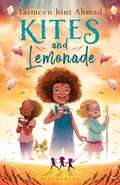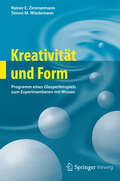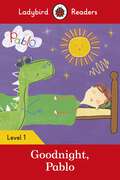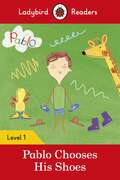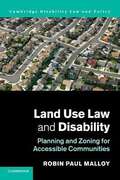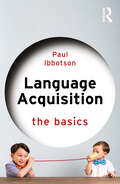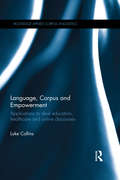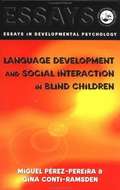- Table View
- List View
Kids in the Syndrome Mix of ADHD, LD, Autism Spectrum, Tourette's, Anxiety, and More!: The one-stop guide for parents, teachers, and other professionals
by Tony Attwood Martin L. KutscherThe completely updated and expanded new edition of this well-established text incorporates DSM-5 changes as well as other new developments. The all-in-one guide covers the whole range of often co-existing neuro-behavioral disorders in children - from attention deficit hyperactivity disorder (ADHD), obsessive-compulsive disorder, and anxiety, to autism spectrum disorders, nonverbal learning disabilities, Tourette's, sensory integration problems, and executive dysfunction. A completely revised chapter on the autism spectrum by Tony Attwood explains not only new understanding in the field, but the new diagnostic criteria, and the anticipated usage of the term 'Asperger's Syndrome'. Dr. Kutscher provides accessible information on causes, symptoms, interactions with other conditions, and treatments. He presents effective behavioral strategies for responding to children who display traits of these disorders - whether at home, at school, or in other settings - along with case vignettes and practical tips. Finally, a chapter on the role of medications summarizes current knowledge. The author's sympathetic yet upbeat approach and skillful explanations of the inner world of children in the syndrome mix make this an invaluable companion for parents, teachers, professionals, and anyone else who needs fast and to-the-point advice on children with special needs.
Kids in the Syndrome Mix of ADHD, LD, Autism Spectrum, Tourette's, Anxiety, and More!: The one-stop guide for parents, teachers, and other professionals (PDF)
by Martin L. Kutscher Tony AttwoodThe completely updated and expanded new edition of this well-established text incorporates DSM-5 changes as well as other new developments. The all-in-one guide covers the whole range of often co-existing neuro-behavioral disorders in children – from attention deficit hyperactivity disorder (ADHD), obsessive-compulsive disorder, and anxiety, to autism spectrum disorders, nonverbal learning disabilities, Tourette's, sensory integration problems, and executive dysfunction. A completely revised chapter on the autism spectrum by Tony Attwood explains not only new understanding in the field, but the new diagnostic criteria, and the anticipated usage of the term 'Asperger's Syndrome'. Dr. Kutscher provides accessible information on causes, symptoms, interactions with other conditions, and treatments. He presents effective behavioral strategies for responding to children who display traits of these disorders – whether at home, at school, or in other settings – along with case vignettes and practical tips. Finally, a chapter on the role of medications summarizes current knowledge. The author's sympathetic yet upbeat approach and skillful explanations of the inner world of children in the syndrome mix make this an invaluable companion for parents, teachers, professionals, and anyone else who needs fast and to-the-point advice on children with special needs.
Kids, Music ‘n’ Autism: Bringing out the Music in Your Child
by Dorita S. BergerMany children with autism feel a natural connection with music, but don't always find it easy to participate in musical activities. Packed with tips, advice and activities, this book shows how music and rhythm can help with brain development and quality of life, and how to encourage a genuine enjoyment of music. Dr Berger draws on her many years of experience in music-based clinical work, teaching and coaching, to answer common questions regarding musical interactions for children with autism. From what instrument to choose, how to find the right teacher, how to get your child to practice music, and even taking children to public music events, this book has all the essential information for you to dip into as and when needed. With practical information to help you solve problems that may arise, such as sensory overload, let this book guide you and your child towards positive interactions with music, regardless of whether or not they have prior musical abilities.
Kids, Music ‘n’ Autism: Bringing out the Music in Your Child (PDF)
by Dorita S. BergerMany children with autism feel a natural connection with music, but don't always find it easy to participate in musical activities. Packed with tips, advice and activities, this book shows how music and rhythm can help with brain development and quality of life, and how to encourage a genuine enjoyment of music. Dr Berger draws on her many years of experience in music-based clinical work, teaching and coaching, to answer common questions regarding musical interactions for children with autism. From what instrument to choose, how to find the right teacher, how to get your child to practice music, and even taking children to public music events, this book has all the essential information for you to dip into as and when needed. With practical information to help you solve problems that may arise, such as sensory overload, let this book guide you and your child towards positive interactions with music, regardless of whether or not they have prior musical abilities.
Kika & Me: How one extraordinary guide dog changed my world
by Dr Amit Patel‘Inspiring and compelling . . . rekindles one's faith in human nature' Andrew Marr'An uplifting read' Cosmopolitan Amit Patel is working as a trauma doctor when a rare condition causes him to lose his sight within thirty-six hours. Totally dependent on others and terrified of stepping outside with a white cane after he's assaulted, he hits rock bottom. He refuses to leave home on his own for three months. With the support of his wife Seema he slowly adapts to his new situation, but how could life ever be the way it was? Then his guide dog Kika comes along . . . But Kika’s stubbornness almost puts her guide dog training in jeopardy – could her quirky personality be a perfect match for someone? Meanwhile Amit has reservations – can he trust a dog with his safety? Paired together in 2015, they start on a journey, learning to trust each other before taking to the streets of London and beyond. The partnership not only gives Amit a renewed lease of life but a new best friend. Then, after a video of an irate commuter rudely asking Amit to step aside on an escalator goes viral, he sets out with Kika by his side to spread a message of positivity and inclusivity, showing that nothing will hold them back.From the challenges of travelling when blind to becoming a parent for the first time, Kika & Me is the moving, heart-warming and inspirational story of Amit’s sight-loss journey and how one guide dog changed his world.
Kindergarten and ASD: How to Get the Best Possible Experience for Your Child
by Margaret OliverKids with ASD take a big leap when they start kindergarten and parents have as much to learn about school expectations and available services. This book will take away the stress of the move to kindergarten, giving parents key information and the "how-to's" to make the transition as smooth as possible and be the best advocates for their child.
A Kit Bag for Promoting Positive Behaviour in the Classroom
by Nicola Morgan Gill EllisDesigned to tackle challenging behaviour before it occurs and make the learning environment more pleasant and constructive for everyone, this invaluable took kit supplies teachers with a wealth of strategies for dealing with everything from calling out to aggressive behaviour with steps to ensure positive behaviour is continually reinforced.
Kites and Lemonade
by Yasmeen bint AhmadAn amazing journey of secrets, self-discovery, kites, and lemonade!Leena, who suffers from selective mutism, and her family move to Riyadh because of her father's job. Her new home is in a modern apartment building where she meets and makes friends with Rima, a neighbour who is blind, and Jojo, who has a secret. Together the girls encounter a clever cat, come across an ancient key, and find a mysterious old workshop full of books, inventions, and trinkets hidden under their building. Join them on their exploration of their amazing discovery and its secrets!Who tampered with Leena and Rima's lemonade? Where did the clever cat come from? And whose kite will win at the Festival?
KLIM
by Michael KlimAs one of Australia's most celebrated athletes, Michael Klim's impact extends far beyond the pool.Klim's journey to greatness began behind the Iron Curtain, in communist-era Poland. His family made a bid for freedom in the 1980s and immigrated to Australia, where swimming became his passport into a new culture and eventually led him to become one of his adopted country's great sporting heroes.His crowning moment came at the 2000 Sydney Olympics, where he captured the hearts of millions with his gold medal performances and world record-breaking swims.But being a champion athlete does not come without personal challenges. Beyond his achievements in the pool, Klim's life has been equally compelling. Through transitions in the business world, family life and major health trials, his natural buoyancy kept him afloat - until he faced a crisis that forced him to reassess his life and fight for his future.From the heights of Olympic glory to the depths of personal adversity, KLIM is a testament to the power of passion, perseverance and the unsinkable human spirit.'An inspiring and sometimes shocking insight into the man behind the medals.' IAN THORPE'Michael Klim's finest moment isn't Olympic glory - it's the courage he summoned to share himself so honestly in this sports memoir for the ages.' RICH ROLL
Körperlicher Umbruch: Über das Erleben chronischer Krankheit und spät erworbener Behinderung (Medical Humanities #11)
by Bernhard RicharzWas bedeutet es in den westlichen Gesellschaften der Jahrtausendwende, chronisch krank zu werden oder dauerhaft mit einer Behinderung zu leben? Ausgehend von subjektiven Erfahrungen Betroffener wirft Bernhard Richarz den Blick auf das somatische Geschehen, dessen prozesshafte individuelle psychische Verarbeitung und die soziokulturellen Rahmenbedingungen. Er leitet chronische Krankheit und Behinderung aus einer Phänomenologie des Körpers ab und ordnet die subjektive Darstellung des Erlebens in den Prozess der Identitätsarbeit ein. Damit eröffnet er den Blick auf das Zusammenwirken von Körper, Selbst und Alterität im Kontext der Persönlichkeitsentwicklung.
Kreativität und Form: Programm eines Glasperlenspiels zum Experimentieren mit Wissen
by Rainer E. Zimmermann Simon M. WiedemannAusgehend von der Idee des Glasperlenspiels, die Hermann Hesse in seinem gleichnamigen Roman entwirft, haben die Autoren in diesem Band die Möglichkeiten und Grenzen eines solchen Spiels im Umgang mit Wissen ausgelotet. Sie zeigen neue Methoden für das Wissensmanagement auf und verbinden dafür Erkenntnisse verschiedener Wissenschaftsgebiete wie Logik, System- und Erkenntnistheorie sowie Semiotik, Kognition und Kommunikation. Das begleitende Computerprogramm unterstützt Leser beim Experimentieren mit Wissen.
Ladybird Readers Level 1 - Pablo - Goodnight Pablo (Ladybird Readers)
by Ladybird PabloLadybird Readers is an ELT graded reader series for children aged 3-11 learning English as a foreign or second language. The series includes traditional tales, popular characters, modern stories, and non-fiction.· Beautifully illustrated books, carefully written by language learning experts· Structured language progression to develop children's reading, writing, speaking, listening and critical thinking skills· Eight levels follow the Common European Framework of Reference for language learning (CEFR)· Language activities provide preparation for the Cambridge English Pre-A1 to A2 (YLE) tests· A unique code in each printed book provides access to online audio, extra activities and learning resourcesGoodnight Pablo, aLevel 1 Reader, is Pre-A1 in the CEFR framework and includes practice for the Cambridge English Pre-A1 Starters tests. Short sentences contain a maximum of two clauses, using the present tense and some simple adjectives.Pablo cannot sleep in the dark. He does not like the dark. He draws his friends.Visit the Ladybird Education website for more information.
Ladybird Readers Level 1 - Pablo - Pablo Chooses his Shoes (Ladybird Readers)
by Ladybird PabloLadybird Readers is an ELT graded reader series for children aged 3-11 learning English as a foreign or second language. The series includes traditional tales, popular characters, modern stories, and non-fiction.· Beautifully illustrated books, carefully written by language learning experts· Structured language progression to develop children's reading, writing, speaking, listening and critical thinking skills· Eight levels follow the Common European Framework of Reference for language learning (CEFR)· Language activities provide preparation for the Cambridge English Pre-A1 to A2 (YLE) tests· A unique code in each printed book provides access to online audio, extra activities and learning resourcesPablo Chooses his Shoes, a Level 1 Reader, is Pre-A1 in the CEFR framework and includes practice for the Cambridge English Pre-A1 Starters tests. Short sentences contain a maximum of two clauses, using the present tense and some simple adjectives.Pablo is going to Granny's house today. "Can we go, too?" ask Pablo's friends. Pablo's blue shoes ask "can we go, too?"Visit the Ladybird Education website for more information.
Land Use Law And Disability: Planning And Zoning For Accessible Communities (Cambridge Disability Law And Policy Ser.)
by Robin Paul MalloyIn Land Use Law and Disability, Robin Paul Malloy argues that our communities need better planning to be safely and easily navigated by people with mobility impairment and to facilitate intergenerational aging in place. To achieve this, communities will need to think of mobility impairment and inclusive design as land use and planning issues, in addition to understanding them as matters of civil and constitutional rights. Although much has been written about the rights of people with disabilities, little has been said about the interplay between disability and land use regulation. This book undertakes to explain mobility impairment, as one type of disability, in terms of planning and zoning. The goal is to advance our understanding of disability in terms of planning and zoning to facilitate cooperative engagement between disability rights advocates and land use professionals. This in turn should lead to improved community planning for accessibility and aging in place.
Language Acquisition: The Basics (The Basics)
by Paul IbbotsonLanguage Acquisition: The Basics is an accessible introduction to the must-know issues in child language development. Covering key topics drawn from contemporary psychology, linguistics and neuroscience, readers are introduced to fundamental concepts, methods, controversies, and discoveries. It follows the remarkable journey children take; from becoming sensitive to language before birth, to the time they string their first words together; from when they use language playfully, to when they tell stories, hold conversations, and share complex ideas. Using examples from 73 different languages, Ibbotson sets this development in a diverse cross-cultural context, as well as describing the universal psychological foundations that allow language to happen. This book, which includes further reading suggestions in each chapter and a glossary of key terms, is the perfect easy-to-understand introductory text for students, teachers, clinicians or anyone with an interest in language development. Drawing together the latest research on typical, atypical and multilingual development, it is the concise beginner's guide to the field.
Language Acquisition: The Basics (The Basics)
by Paul IbbotsonLanguage Acquisition: The Basics is an accessible introduction to the must-know issues in child language development. Covering key topics drawn from contemporary psychology, linguistics and neuroscience, readers are introduced to fundamental concepts, methods, controversies, and discoveries. It follows the remarkable journey children take; from becoming sensitive to language before birth, to the time they string their first words together; from when they use language playfully, to when they tell stories, hold conversations, and share complex ideas. Using examples from 73 different languages, Ibbotson sets this development in a diverse cross-cultural context, as well as describing the universal psychological foundations that allow language to happen. This book, which includes further reading suggestions in each chapter and a glossary of key terms, is the perfect easy-to-understand introductory text for students, teachers, clinicians or anyone with an interest in language development. Drawing together the latest research on typical, atypical and multilingual development, it is the concise beginner's guide to the field.
Language and Social Disadvantage: Theory into Practice
by Judy Clegg Jane GinsborgLanguage and Social Disadvantage critically analyses and reviews the development of language in direct relation to social disadvantage in the early years and beyond. Definitions and descriptions of social disadvantage are addressed and wider aspects discussed. Theory and practice in relation to language development and social disadvantage are explored. The book is divided into two sections: the first addresses the theoretical associations and relationships between social disadvantage and language, where cognition, literacy, behaviour, learning, socio-emotional development, intervention and outcomes are considered in depth. The second section applies the theory to practice, where real-life intervention studies in nurseries, schools and other contexts are reported. Research and practice based in the UK is a focus of all the chapters and research reports. A genuinely interdisciplinary and collaborative approach is taken using perspectives from speech and language therapy, psychology and education. The book is ideal for professionals and students interested in the study of language development and intervention in the context of social disadvantage.
Language, Corpus and Empowerment: Applications to deaf education, healthcare and online discourses (Routledge Applied Corpus Linguistics)
by Luke CollinsLanguage, Corpus and Empowerment applies a novel corpus-driven approach to the exploration of the concept of empowerment in healthcare. The book proposes an innovative corpus-based methodology for finding evidence of empowerment in language use, using data from a video intervention delivered to families of deaf children, as well as assessing the effects of the intervention on the family. Language, Corpus and Empowerment provides a working definition of empowerment which incorporates concepts from linguistics and learning theory; uses corpus analysis to provide evidence of how video interventions can transform people’s perspectives; examines this new methodology as a potential tool for analysing conversational data longitudinally and at a case-by-case level; demonstrates how a corpus-based methodological approach can be applied in conjunction with other language-based approaches, such as discourse analysis and conversation analysis, to explore the ways in which complex social processes occur in interaction; makes a valuable development in the assessment of the impact of healthcare interventions and the language of empowerment. Insightful and ground-breaking, Language, Corpus and Empowerment is essential reading for anyone undertaking research within corpus linguistics.
Language, Corpus and Empowerment: Applications to deaf education, healthcare and online discourses (Routledge Applied Corpus Linguistics)
by Luke CollinsLanguage, Corpus and Empowerment applies a novel corpus-driven approach to the exploration of the concept of empowerment in healthcare. The book proposes an innovative corpus-based methodology for finding evidence of empowerment in language use, using data from a video intervention delivered to families of deaf children, as well as assessing the effects of the intervention on the family. Language, Corpus and Empowerment provides a working definition of empowerment which incorporates concepts from linguistics and learning theory; uses corpus analysis to provide evidence of how video interventions can transform people’s perspectives; examines this new methodology as a potential tool for analysing conversational data longitudinally and at a case-by-case level; demonstrates how a corpus-based methodological approach can be applied in conjunction with other language-based approaches, such as discourse analysis and conversation analysis, to explore the ways in which complex social processes occur in interaction; makes a valuable development in the assessment of the impact of healthcare interventions and the language of empowerment. Insightful and ground-breaking, Language, Corpus and Empowerment is essential reading for anyone undertaking research within corpus linguistics.
Language Development and Social Interaction in Blind Children (Psychology Press & Routledge Classic Editions)
by Gina Conti-Ramsden Miguel Perez-PereiraThe Classic Edition of this foundational text includes a new preface from Miguel Pérez-Pereira, examining how the field has developed since first publication. The volume provides an in-depth account of blind children's developing communicative abilities, with particular emphasis on social cognition and language acquisition from infancy to early school age. It provides insights into why the development of blind children may differ from that of sighted children and explores development of "theory of mind" and perspective taking in language learning. It also discusses the caregiver–child interaction, research on early intervention and practical strategies for blind children that can assist parents and practitioners. The up-to-date preface discusses recent neurological research and the comparison between the psychological development of visually impaired and autistic children. Language Development and Social Interaction in Blind Children continues to facilitate dialogue between those interested in the study of typically developing children and those interested in the development of children who are blind, and challenges some widely held beliefs about the development of communication in blind children.
Language Development and Social Interaction in Blind Children (Psychology Press & Routledge Classic Editions)
by Gina Conti-Ramsden Miguel Perez-PereiraThe Classic Edition of this foundational text includes a new preface from Miguel Pérez-Pereira, examining how the field has developed since first publication. The volume provides an in-depth account of blind children's developing communicative abilities, with particular emphasis on social cognition and language acquisition from infancy to early school age. It provides insights into why the development of blind children may differ from that of sighted children and explores development of "theory of mind" and perspective taking in language learning. It also discusses the caregiver–child interaction, research on early intervention and practical strategies for blind children that can assist parents and practitioners. The up-to-date preface discusses recent neurological research and the comparison between the psychological development of visually impaired and autistic children. Language Development and Social Interaction in Blind Children continues to facilitate dialogue between those interested in the study of typically developing children and those interested in the development of children who are blind, and challenges some widely held beliefs about the development of communication in blind children.
Language Development And Social Interaction In Blind Children
by Miguel Perez Pereira Gina Conti-RamsdenThis book provides an up-to-date account of blind children's developing communicative abilities with particular emphasis on social cognition and language acquisition from infancy to early school age. It purports to foster dialogue between those interested in the study of typically developing children and those interested in the development of children who are blind and to provide insights and new explanations of why the development of blind children may differ from that of sighted children. The book also aims to identify and examine current theoretical issues which are likely to be at the centre of developments in the fields of child language and developmental psychology. Language Development and Social Interaction in Blind Childrenis also a timely book. The study of blind children's development constitutes a unique opportunity to study the effect of vision on development, and more specifically on the development of language and certain aspects of social cognition. Current interest in the development of "theory of mind" and perspective taking in language learning, make the case of blind children crucial to our understanding of certain aspects of psychological functioning. The book explores these issues, challenges some widely-held beliefs about the development of communication in blind children, and provides a cohesive picture of our knowledge to date.
Language Development for Science: Activities for Home
by Marion Nash Jackie LoweThese simple play-based activities are ideal for teachers to copy and give out to parents who want to know how to help their child improve his or her science language skills and have fun at the same time. Activities are linked directly to the school-based Language Development Circle Time sessions, but can also be used independently. There is a clear structure and progression of ideas, with supporting black-line drawings to acts as prompts and simple record - keeping system to support home/school communication.
Language Development for Science: Activities for Home
by Marion Nash Jackie LoweThese simple play-based activities are ideal for teachers to copy and give out to parents who want to know how to help their child improve his or her science language skills and have fun at the same time. Activities are linked directly to the school-based Language Development Circle Time sessions, but can also be used independently. There is a clear structure and progression of ideas, with supporting black-line drawings to acts as prompts and simple record - keeping system to support home/school communication.
Language Development for Science: Circle Time Sessions to Improve Language Skills
by Marion Nash Jackie LoweThis book is the first of its kind to help practitioners specifically develop children's language skills in Science. The book incudes: guidelines to help teachers set up, run and assess circle-time sessions ideas for promoting children's thinking skills and emotional literacy video CD containing explanation and demonstration of the programme and its implementation, with comments from staff who have used it.





